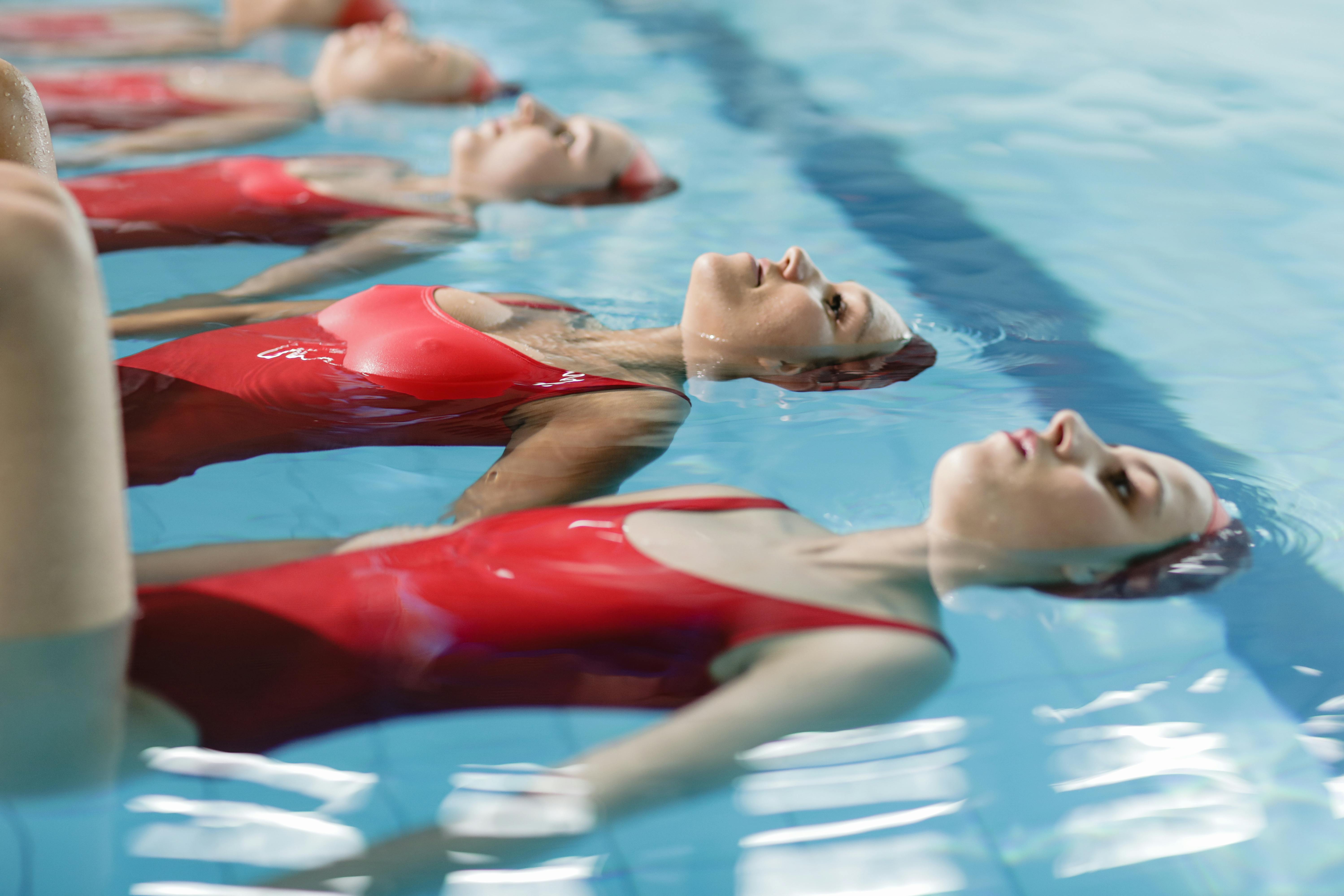Synchronized Swimming: The Aquatic Ballet Revolutionizing Athletic Art
Beneath the surface of competitive swimming lies a captivating world where strength meets grace, and athleticism blends seamlessly with artistic expression. Synchronized swimming, a discipline often misunderstood and underappreciated, is redefining the boundaries of aquatic sports and challenging perceptions of what it means to be an elite athlete. This article dives deep into the mesmerizing realm of synchronized swimming, exploring its rich history, technical intricacies, and the extraordinary physical and mental demands placed on its practitioners.

Katherine Curtis, an American swimming instructor, is credited with developing the first synchronized swimming routines and organizing the first competition in 1939. The sport quickly gained traction, with the first U.S. National Championship held in 1945. As interest grew, so did the need for standardization and organization. In 1952, the Fédération Internationale de Natation (FINA) recognized synchronized swimming as an official discipline, paving the way for its inclusion in major international competitions.
The sport’s Olympic debut came in 1984 at the Los Angeles Games, featuring solo and duet events. Since then, synchronized swimming has continued to evolve, with team events added in 1996 and mixed duets introduced in 2015 at the FINA World Championships. Today, it stands as a testament to the harmonious blend of athletic prowess and artistic expression in aquatic sports.
The Technical Marvels: Decoding the Complexity of Synchronized Swimming
At first glance, synchronized swimming may appear effortless, with athletes gracefully gliding through the water in perfect unison. However, beneath the surface lies a world of intense physical exertion, precise technique, and unwavering concentration. The sport demands a unique combination of strength, flexibility, endurance, and breath control that few other disciplines can match.
One of the most challenging aspects of synchronized swimming is the ability to perform complex movements while inverted and submerged. Athletes must maintain perfect body control and spatial awareness while executing intricate leg movements, often referred to as “eggbeater kicks,” to stay afloat and propel themselves through the water. This technique requires immense core strength and leg power, allowing swimmers to support their upper bodies above the water’s surface while their legs work tirelessly below.
Breath control is another critical component of synchronized swimming. Athletes must learn to hold their breath for extended periods, sometimes up to a minute, while performing strenuous underwater movements. This skill is honed through years of training and requires exceptional lung capacity and mental fortitude.
The choreography in synchronized swimming routines is meticulously crafted, combining elements of dance, gymnastics, and swimming. Swimmers must execute precise movements in perfect synchronization with their teammates and the music, all while maintaining a smile and making the routine appear effortless. This level of coordination and timing demands countless hours of practice and an innate sense of rhythm and musicality.
The Physical Demands: Athleticism Beyond the Surface
Synchronized swimming is often underestimated in terms of its physical demands, but the reality is that it requires an extraordinary level of fitness and stamina. Athletes in this sport undergo rigorous training regimens that rival those of any elite athlete in more traditional sports.
Cardiovascular endurance is paramount in synchronized swimming. Routines can last up to four minutes, during which athletes are in constant motion, alternating between underwater and above-water sequences. This requires a high level of aerobic capacity and the ability to perform at maximum intensity while managing oxygen deprivation.
Strength training is also a crucial component of synchronized swimming preparation. Athletes must develop powerful core muscles to maintain stability and control during inverted positions and lifts. Leg strength is essential for propulsion and sustaining the eggbeater kick, while upper body strength is necessary for executing arm movements and supporting teammates during lifts and formations.
Flexibility is another key attribute of synchronized swimmers. The sport demands a wide range of motion in the shoulders, hips, and spine to achieve the graceful and often contorted positions required in routines. Swimmers engage in extensive stretching and flexibility training to improve their range of motion and prevent injuries.
The combination of these physical demands makes synchronized swimming one of the most comprehensive full-body workouts available. Athletes develop exceptional muscular endurance, cardiovascular fitness, and overall body awareness through their training and competition.
The Mental Game: Psychology and Artistry in Synchronized Swimming
While the physical aspects of synchronized swimming are undoubtedly challenging, the mental demands of the sport are equally intense. Athletes must possess a unique blend of focus, creativity, and psychological resilience to excel in this discipline.
Concentration and mental toughness are crucial in synchronized swimming. Athletes must maintain unwavering focus throughout their routines, executing complex movements with precision while remaining aware of their teammates’ positions and the overall choreography. The ability to perform under pressure is essential, as even the slightest mistake can be glaringly obvious in a sport that demands perfect synchronization.
Creativity plays a significant role in synchronized swimming, particularly in the choreography and artistic expression of routines. Athletes and coaches work together to develop innovative and captivating performances that push the boundaries of what is possible in the water. This artistic element adds a unique dimension to the sport, requiring swimmers to not only be physically adept but also expressive and emotive in their movements.
The team dynamics in synchronized swimming are also crucial to success. Athletes must develop a deep sense of trust and connection with their teammates, as many elements of routines require precise timing and coordination between multiple swimmers. This fosters a strong sense of camaraderie and teamwork, which is essential for achieving the level of synchronization required at the highest levels of competition.
Training Methodologies: Crafting the Perfect Synchronized Swimmer
The journey to becoming an elite synchronized swimmer is a demanding and multifaceted process that requires a carefully structured training program. Coaches and athletes employ a variety of methods to develop the unique skill set required for success in this sport.
Land training forms a significant part of synchronized swimming preparation. Athletes engage in strength and conditioning exercises to build the necessary muscular endurance and power. Pilates and yoga are often incorporated into training regimens to improve core strength, flexibility, and body awareness. Dancers and choreographers may be brought in to help refine movement quality and artistic expression.
In-water training is, of course, the cornerstone of synchronized swimming preparation. Athletes spend countless hours in the pool, perfecting their technique, synchronization, and routines. Drills focusing on specific elements such as sculling (hand movements used for propulsion and stability), figure training (individual technical elements), and breath control are essential components of daily practice.
Video analysis has become an increasingly important tool in synchronized swimming training. Coaches use underwater and above-water footage to analyze technique, synchronization, and overall performance. This allows for precise feedback and adjustments to improve both individual and team performance.
Mental training is also a crucial aspect of synchronized swimming preparation. Athletes work with sports psychologists to develop strategies for managing stress, maintaining focus, and visualizing successful performances. Meditation and mindfulness techniques are often employed to enhance concentration and emotional control.
The Future of Synchronized Swimming: Innovations and Challenges
As synchronized swimming continues to evolve, the sport faces both exciting opportunities and significant challenges. Technological advancements are playing an increasingly important role in training and performance analysis. Wearable devices that track movement patterns and physiological data are being used to optimize training and prevent injuries. Virtual reality simulations are being explored as a tool for mental preparation and routine visualization.
The inclusion of mixed-gender events in international competitions has opened up new possibilities for choreography and artistic expression. This change has also helped to challenge gender stereotypes associated with the sport and attract a more diverse pool of athletes.
However, synchronized swimming also faces challenges in terms of global participation and recognition. The sport remains more popular in certain regions, particularly Europe and North America, and efforts are being made to promote its growth in other parts of the world. There is also an ongoing push to increase media coverage and public understanding of the sport’s complexity and athletic demands.
Judging criteria and scoring systems in synchronized swimming continue to evolve to ensure fair and accurate assessment of performances. The balance between technical merit and artistic impression remains a topic of discussion within the sport’s governing bodies.
The Aquatic Art Form Pushing Athletic Boundaries
Synchronized swimming stands as a testament to the incredible potential of the human body and mind when pushed to their limits in an aquatic environment. It challenges our perceptions of what constitutes athletic excellence, combining the raw power and endurance of competitive swimming with the grace and artistic expression of dance.
As the sport continues to evolve and gain recognition, it offers a unique platform for athletes to showcase their skills, creativity, and teamwork. The dedication and passion exhibited by synchronized swimmers serve as an inspiration to athletes and spectators alike, reminding us of the beauty and complexity that can be achieved when physical prowess meets artistic vision.
From its humble beginnings as a form of aquatic entertainment to its current status as an Olympic discipline, synchronized swimming has come a long way. As it faces the challenges and opportunities of the future, one thing remains certain: the sport will continue to captivate and amaze, pushing the boundaries of what is possible in the world of aquatic athletics.





